Nexus S and Android 2.3 Review: Gingerbread for the Holidays
by Brian Klug on December 14, 2010 4:08 PM EST- Posted in
- Smartphones
- Samsung
- Nexus S
- Gingerbread
- Android 2.3
- Mobile
Baseband and Cellular
On the far left side of the Nexus S is another region with the indicative flex/tape appearance that belies an antenna. From experimentation, this region is for WiFi and Bluetooth. The active region for the cellular region is at the very bottom of the Nexus S, as it is with the overwhelming majority of other phones.
We ran our normal suite of attenuation tests on the Nexus S and compared to the rest. The Nexus One had a mini antennagate of its own back when it came out, no doubt Google and Samsung both wanted to avoid a similar situation with the Nexus S. The table says it all - attenuation from holding the device is in line with the 15 dBm or so we’re used to seeing. There aren’t any attenuation issues with the Nexus S.
| Signal Attenuation Comparison in dB—Lower is Better | |||||||
| Cupping Tightly | Holding Naturally | On an Open Palm | |||||
| Nexus S | 13.3 | 6.1 | 4.3 | ||||
| Samsung Fascinate | 10.0 | 5.0 | 0.0 | ||||
| Droid 2 | 11.5 | 5.1 | 4.5 | ||||
| BlackBerry Torch | 15.9 | 7.1 | 3.7 | ||||
| Dell Streak | 14.0 | 8.7 | 4.0 | ||||
| Droid X | 15.0 | 5.1 | 4.5 | ||||
| iPhone 4 | 24.6 | 19.8 | 9.2 | ||||
| iPhone 3GS | 14.3 | 1.9 | 0.2 | ||||
| Nexus One | 17.7 | 10.7 | 6.7 | ||||
I did notice however that the Nexus S likes falling back to EDGE from UMTS and HSPA a whole lot. I’ve only had a limited time to play with T-Mobile’s 3G turned 4G network, so I’m not crying foul, but I did notice that voice calls often migrate over to EDGE if you’re in marginal (but not awful) UMTS coverage, and data does the same from time to time. During my battery life call tests, I had to re-initiate the call three times due to the Nexus S falling from UMTS (3G) voice to GSM and not wanting to pollute data. Signal in my office is admittedly on the lower end at -91 dBm, but still within an acceptable range. The phone will automatically hand back on to UMTS, then to HSPA after a while, but the fallback to EDGE seems much more aggressive than I’ve ever remembered any device being.
I’ve run over 100 speedtests in the short three or so days I’ve had the Nexus S in my HSPA+ enabled T-Mobile market. I saw maximum throughput of 5.1 megabits/s down, 0.64 megabits/s up and average speeds of 2.55 megabits/s down, 0.51 megabits/s up over that time using the Speedtest.net application to a sever in the same city.
The Nexus S is a tri-band HSPA device and quad-band GSM device as shown in the table above. Just like the launch-day Nexus One, the Nexus S won’t work on any 3G in the USA except T-Mobile. You’ll get EDGE if you stick an AT&T SIM inside.
| Nexus S - Network Support | |||||
| Tri-Band HSPA | 900 / 1700 / 2100 MHz | ||||
| Quad-Band GSM/EDGE | 850 / 900 / 1800 / 1900 MHz | ||||
| HSDPA/HSUPA | 7.2Mbps / 5.76Mbps | ||||
When the Nexus One came out - before I signed on with AnandTech in this capacity - I wrote that the problem with the Nexus One concept was that the hardware didn’t have a pentaband UMTS radio. The promise was completely carrier-agnostic phone shopping, yet the only choice you could get with 3G UMTS/HSPA support was T-Mobile. Of course, an AT&T version came later, but the problem remained - hardware wasn’t carrier agnostic, so how could the promise ever be a reality? I’m disappointed that the same thing applies to the Nexus S, although this time around there’s no guarantee we’ll get an AT&T version at all. There are obvious engineering challenges to building pentaband UMTS/HSPA hardware, but if Nokia can do it with the N8 and a select few other phones can pull it off, it can’t be that hard.
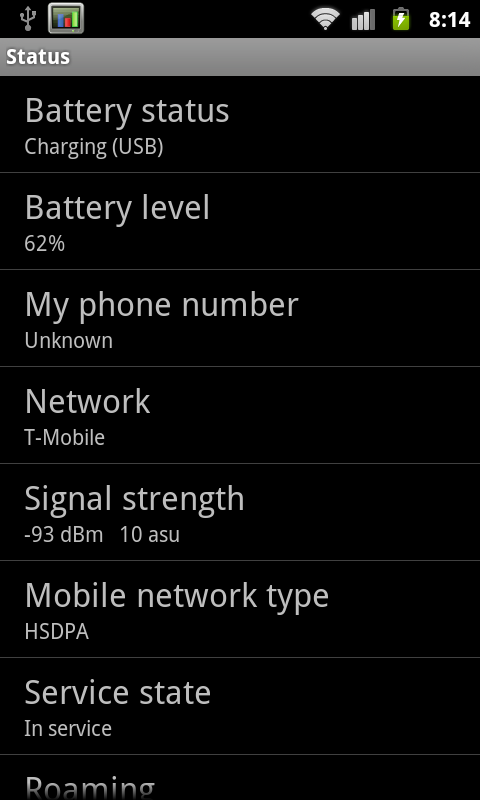
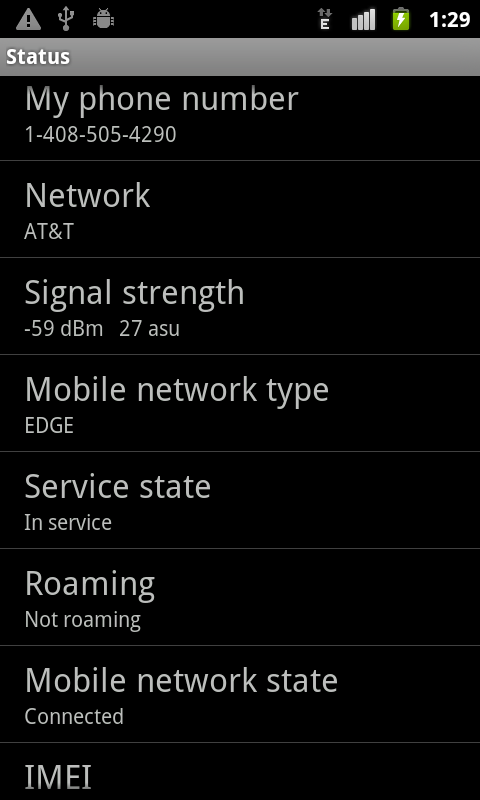
The other thing on everyone’s mind is how much HSPA+ 21.1 differs from HSDPA 7.2 or 14.4 in practice. Well, I’ve been sitting on a myTouch 4G for a while waiting for some T-Mobile service to test with, and in comes a Nexus S with a T-Mobile SIM card. Naturally, I carried the two with me and ran tests at almost the same places. The results are pretty interesting. On the myTouch 4G, I saw maximum throughput of 7.18 megabits/s down, and 0.66 megabits/s up, with an average of 2.75 megabits/s down, and 0.56 megabits/s up.
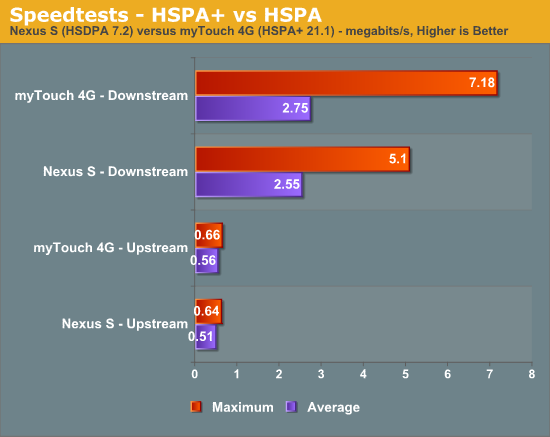
The subtle difference in most cases actually makes sense. The difference between HSDPA 14.4 and HSPA+ 21.1 is just a change in modulation from 16-QAM to 64-QAM. The symbol rates for those two are the same, they just differ in the modulation scheme by a factor of 4 more decision points. Since 64-QAM requires better SNR over 16-QAM, we really only see that modulation scheme when we’re close to the tower. When that’s the case and SNR is really good, HSPA+ of the 21.1 sort does pay off, and you get impressive speeds such as that 7.18 megabit/s speedtest. However, when you’re even just half way out of the cell radius, SNR is most likely no longer good enough for 64-QAM to maintain an acceptable frame error rate, and you’ll fall back to 16-QAM just the same. In reality, HSPA+ only becomes super interesting when MIMO is added into the picture, and even moreso when dual-carrier links are added. MIMO lets us multiplex the signal spatially, and multi-carrier effectively aggregates carriers together for a faster link.
WiFi range on the Nexus S is what I’m used to seeing for smartphones. I make it to the same place right at the curb with the Nexus S as I do other devices. The Nexus S has 802.11 n/b/g support, and I saw it connect at 72 megabits/s on my 802.11n network. In testing, the Nexus S downloaded our local 100 MB PDF over at 15 megabits/s over WiFi.
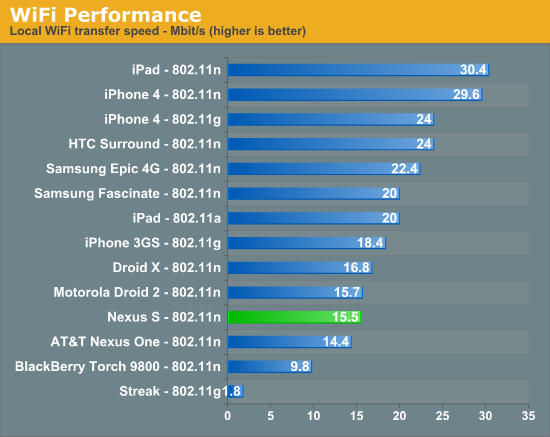
Rounding out this section is a note that the Nexus S suffers from none of the GPS issues that plague the Galaxy S. I tested thoroughly - fixes are fast and accurate over GPS and work like they should using Google location services with WiFi trilateration.


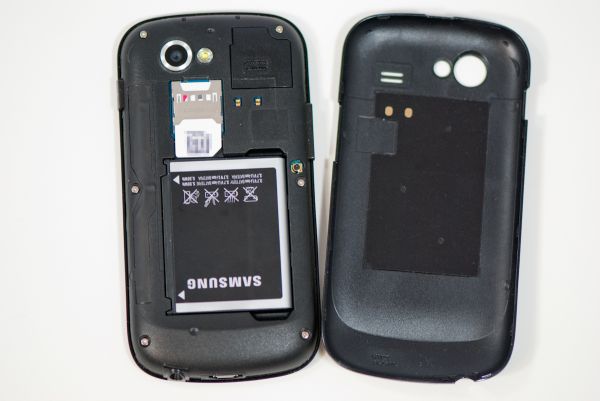
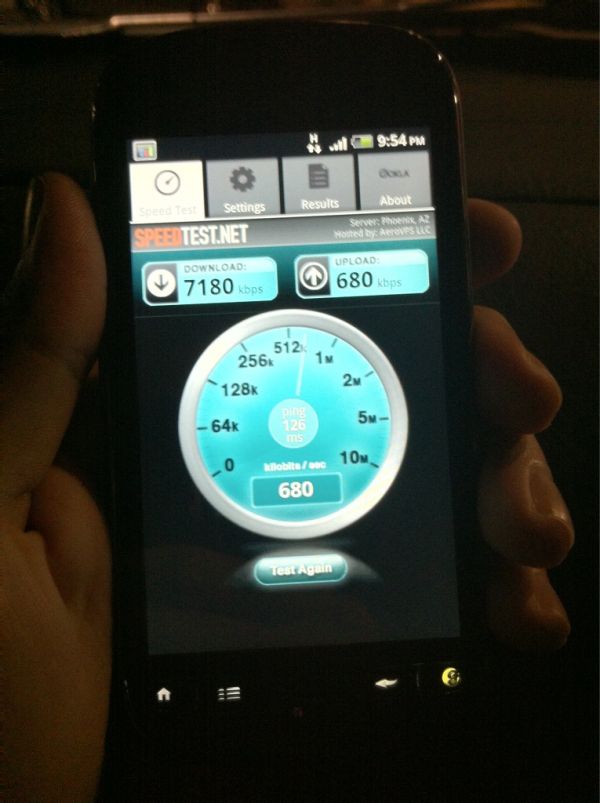








73 Comments
View All Comments
metafor - Wednesday, December 15, 2010 - link
AMOLED's emit light from each subpixel (diode). When it's displaying black, it simply doesn't emit any light. This results in true black; which is why you see their black level at 0.This comes with some limitations, of course, compared to LCD displays. One particular drawback is lack of great bright levels as well as readability in sunlight.
They also take more power when all the individual subpixels are lit up.
Chloiber - Wednesday, December 15, 2010 - link
Alltough I really don't like most of the smartphones from Samsung (just too much cheap plastic), I really liked the review (and the video).I'm really looking forward to Gingerbread - finally smooth Animations. You can already have those, but only with a good custom ROM. Gingerbread + custom ROM will rock the house! :-)
Guspaz - Wednesday, December 15, 2010 - link
I really hope that the phone number (1-408-505-xxxx) on page 6 is not a real phone number...tpurves - Wednesday, December 15, 2010 - link
Interesting to see how little difference the 21MBits/s hspa+ made in your tests.On Canadian HSPA+ 21 networks I've seen speed tests as much as 13 Megabits/sec down and 1.2-1.6 up. That's fast! and nearly twice your measured speeds. Bear in mind those speeds where achieved with a USB 3G adapter not a handset.
http://wirelessnorth.ca/2010/05/24/rogers-21-6mbs-...
spaceboy33 - Wednesday, December 15, 2010 - link
Any idea when the mytouch 4g review will be posted? Currently trying to decide between these two phones and another review as detailed as this one would be a big help.Ullteppet - Wednesday, December 15, 2010 - link
First off, you guys deliver the hands down most thorough articles and reviews the internet has ever seen - and we're ever grateful for your unbiased, hard effort, keep it up!I didn't fully get the video recording though. First page table says it has 720p, but the camera pages states it lacks 720p. Is the table wrong or does it only reflect the potential of the camera, since the limitation seems to be in gingerbread?
Brian Klug - Thursday, December 16, 2010 - link
Oops, you're indeed correct. The Nexus S lacks 720P video recording, at least out of the box with stock 2.3. I'm sure it'll be added in by the XDA-Devs within a few days at max.-Brian
sicofante - Wednesday, December 15, 2010 - link
I know you're an American site and that Americans don't care that much about the biggest phone maker in the world (Nokia). However, since this is published in the worldwide web I believe your comparisons would be more useful to your worldwide audience if you included the newest phones from Nokia, such as the N8 or C7.ojisama - Tuesday, December 21, 2010 - link
I've also been refreshing the main page to see a review of N8 before Christmas, but apparently getting the review out in the time span between the release of the phone in October and Christmas was impossible. (Well, technically the article could still come out before xmas, but now it's too late to get the phone...)Well, apparently there will be an update for the phone soon, so hopefully this will be installed and tested before the article is released...
rcocchiararo - Wednesday, December 15, 2010 - link
Swype has arrow keysSwyping forom "swype button" to "sym button" takes you to that keyboard.